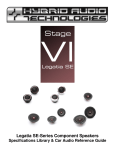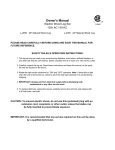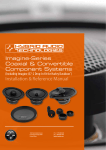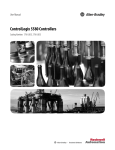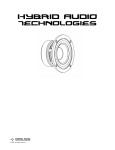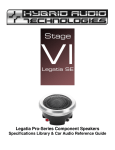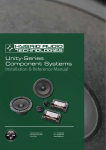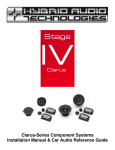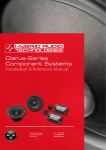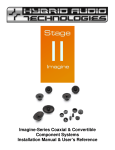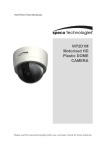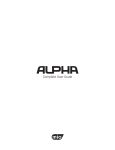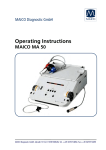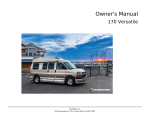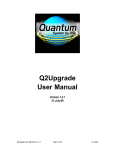Download Legatia SE Carbon Manual
Transcript
Legatia SE Carbon-Series Component Speakers Specifications Library & Car Audio Reference Guide Contents Welcome and Introduction .................................................................................................................................................. 4 Legatia SE Carbon Speaker Design Considerations ...................................................................................................... 5 Motor .................................................................................................................................................................................. 5 Voice Coil........................................................................................................................................................................... 6 Shorting Cup ..................................................................................................................................................................... 6 Cone ................................................................................................................................................................................... 6 Suspension ........................................................................................................................................................................ 7 Basket ................................................................................................................................................................................ 7 Thiele/Small Parameters Introduction ............................................................................................................................... 7 Application to Thiele/Small Parameters to Legatia SE Carbon Designs ................................................................. 8 Enclosure Recommendations .................................................................................................................................... 8 Dipole Applications ....................................................................................................................................................... 8 Legatia L4SE Carbon Midbass ........................................................................................................................................ 10 History .............................................................................................................................................................................. 10 Attributes.......................................................................................................................................................................... 10 Summary ......................................................................................................................................................................... 12 Mechanical Drawing ....................................................................................................................................................... 13 Thiele/Small Parameters ............................................................................................................................................... 14 Frequency Response Graph ........................................................................................................................................ 15 Legatia L6SE Carbon Midbass ........................................................................................................................................ 16 History .............................................................................................................................................................................. 16 Attributes.......................................................................................................................................................................... 16 Summary ......................................................................................................................................................................... 18 Mechanical Drawing ....................................................................................................................................................... 19 Thiele/Small Parameters ............................................................................................................................................... 20 Frequency Response Graph ........................................................................................................................................ 21 Legatia L4G Grille Assembly ............................................................................................................................................ 22 Legatia L6G Grille Assembly ............................................................................................................................................ 23 Advanced System Installation .......................................................................................................................................... 24 Lessons Learned ............................................................................................................................................................ 24 Lesson One: Off-Axis Response.................................................................................................................................. 24 Lesson Two: Equalization of Pathlength Differences ............................................................................................... 24 Lesson Three: The Effect of HRTF, ITD, and IID ...................................................................................................... 26 Lesson Four: Point-Sourcing with Tweeter ................................................................................................................ 27 Lesson Five: Reference ................................................................................................................................................ 27 Advanced Installation of the Legatia SE Carbon Component Systems..................................................................... 28 Mounting Baffle Considerations ................................................................................................................................... 28 Crossovers ...................................................................................................................................................................... 29 Time Correction .............................................................................................................................................................. 30 Scenario 1 ................................................................................................................................................................... 30 Scenario 2 ................................................................................................................................................................... 30 Scenario 3 ................................................................................................................................................................... 31 Amplitude Equalization .................................................................................................................................................. 31 Acoustic Treatment ........................................................................................................................................................ 31 Advanced Installation Conclusions .................................................................................................................................. 32 Warranty .............................................................................................................................................................................. 33 Thank You! .......................................................................................................................................................................... 34 References .......................................................................................................................................................................... 35 Welcome and Introduction Congratulations on your purchase of high performance Legatia SE Carbon-series mobile audio component loudspeakers, and welcome to the world of Hybrid Audio Technologies, where high-end mobile audio loudspeaker development is our passion! When installed and set-up properly, the Legatia SE Carbon component system you have purchased will be the finest loudspeakers you have ever heard and give years of superior performance. Thank you for going “on line” to read and download your User’s Manual. Our offices are located amongst the evergreens in North Georgia USA, and we happen to like trees. Aside from the obvious aesthetic benefits, trees improve our air, protect our water, save energy, and improve economic sustainability. Additionally, it is expensive to print and distribute thousands of copies of an owner’s manual; we’d rather invest our production dollars into an incredible line-up of speaker systems for your listening pleasure. With online resources becoming the main source of information for more and more people, we are pleased that you’re here, reading this manual on line, verses having a print copy which might get read once and put back into the gift box, or worse yet, discarded. With the publication of this specifications library and car audio reference guide, it is our goal to assist the “do it yourself” enthusiast and professional installer alike in getting the highest level of performance out of Legatia SE Carbon component speakers and sets using straight-forward installation advice and practical application of timeless acoustic principles. The first part of this manual is comprised of a specifications library for all of our available Legatia SE Carbon component speakers, passive crossover devices, and available accessory hardware. Simply scroll through the library to learn more about the wide variety of Legatia SE Carbon products. The second part of the manual has been written to be more or less a miniature mobile audio reference guide that can be used to better any sound system, and in particular, a system that utilizes the Legatia SE Carbon component speaker systems. It is an introductory primer to the world of high-end mobile audio; we hope this user’s manual is not only informative, but motivating. Keep it handy throughout your installation process, and any time you go to improve your audio system with other Hybrid Audio Technologies products, or perhaps to take advantage of our lifetime guaranteed value trade-in program. We are confident that if the principles explained in this manual are exercised in your own installation, you will be ecstatic with the sound quality outcome! We realize that you have a choice in loudspeakers, and are thrilled that you have chosen the Legatia SE Carbon series. For more information about Hybrid Audio Technologies, our philosophies regarding high-end mobile audio, to learn more about our lifetime guaranteed value program, and for information about our other products, please visit us online at www.hybrid-audio.com. Thank you, and happy listening! Scott E. Buwalda Founder – Hybrid Audio Technologies Legatia SE Carbon User’s Manual ©Hybrid Audio Technologies Page 4 of 30 Legatia SE Carbon Speaker Design Considerations The Legatia SE Carbon-series component speakers are electrodynamic drivers that are comprised of a diaphragm that is set in motion by a motor system that has both electrical and mechanical components. The Special Edition Carbon midbass designs boast several key elements which enhance the driver’s performance in vehicle-specific applications, notably applications which require a shallow-depth midbass driver, such as typically found in numerous German-manufactured automobiles (Audi, BMW, Porsche, and etc.). Likewise, the Carbon midbass’ can be used at the enduser’s discretion in a variety of automobile settings where a shallow-profile, long-throw midbass is required. The Legatia SE Carbon midbass differ vastly from the Legatia SE-series wide-bandwidth drivers, as follows: • • • • • Considerably shallower mounting depth; Considerably smaller motor profile; Inclusion of a “double-S” treated cloth surround for enhanced excursion, restorative force, compliance, and edge-mode damping, for authoritative midbass operation; Narrower recommended bandwidth operation, as compared to the wide-bandwidth Legatia SE series, but with enhanced midbass and lower midrange authority; Inclusion of a composite carbon fiber cone and dust cap for exceptional strength, while balancing moving mass and resonance frequency; The following design tenets are similar by comparison to the Legatia SE-series wide-bandwidth drivers: • • • • • • • • • • Same basket diameter, mounting hole, and bolt circle diameter as its sibling Legatia SE widebandwidth driver (but with considerably shallower depth and motor diameter, as described above); Incredibly low inductance; High thermal power handling by AES standard; High thermal power handling with suggested crossover; High compliance of motor system; Use of woven dual tinsel lead spider for mechanical balance, improved radial compliance, and to eliminate tinsel lead slap; Inclusion of nickel-plated, spring-loaded binding post terminals for enhanced connectivity; Inclusion of high-energy opposing double-stacked neodymium cup and motor for increased motor performance and smaller diameter motor; Inclusion of aluminum radiator for heat dissipation and increased thermal power handling; Inclusion of rose-tinted, laser-etched back plate cap with Hybrid Audio Technologies logo and Special Edition nomenclature. The following design tenets are typical of all Legatia SE Carbon-series midbass drivers: Motor The motor of the Legatia SE Carbon midbass speakers are paramount to the performance of the drivers, providing for a flat and wide BL curve. The BL curve is flat and extended in all models, yielding exceptional two-way linear excursion, resulting in the Legatia SE Carbon midbass drivers being able to accurately track the input signal. Reduced distortion and greater dynamics are the Legatia SE Carbon User’s Manual ©Hybrid Audio Technologies Page 5 of 30 immediate sonic benefits. The motor includes an opposing double-stacked high-grade NdFeB magnet assembly to improve restorative force, compliance, motor strength, displacement, and power handling, but also to serve a small diameter form-factor. The voice coil fully surrounds the opposing double-stacked magnet. Voice Coil The voice coil diameter of the Legatia SE Carbon range of midbass drivers represents the optimal balance of diameter, power handling, and moving mass. The L4SE Carbon uses a 25.5mm (1-inch) voice coil, and the L6SE Carbon uses a 35.5mm (1.4-inch) voice coil. The voice coil diameter serves several key functions: elevated power handling, dissipation of heat (thereby lowering power compression), and maximizing the size of the magnet assembly for enhanced motor compliance. The voice coils used in all Legatia SE Carbon designs are high-purity aluminum, which is superior to copper for heat dissipation, as well as significantly reduced moving mass. The result is an extremely light weight winding with good power handling and low inductance. How much amplitude a speaker can reproduce depends on the volume of air it excites without overheating. The volume of air that a speaker excites is determined by the surface area of the cone and the excursion capability of the motor system. Xmax is defined as the width of the voice coil that extends beyond the front plate, and relates to how far the speaker can move in either direction without appreciable distortion. The Legatia SE Carbon designs boast exceptional one-way linear excursion (Xmax). Shorting Cup All Legatia SE Carbon midbass drivers come equipped with copper shorting cups. The shorting cups consist of an optimally sized and placed cup of copper (Cu) to create a total inductance profile that is not just low, but flat over stroke, frequency, and power. Inductance is the number one limiter of high frequency extension and modulation of inductance with stroke, frequency and power, and is the primary source of intermodulation distortion (IMD). Cone The shape, weight and strength of the Legatia SE Carbon midbass cones relate directly to the authoritative midbass ability of each design. The Legatia SE Carbon cones are concave-shaped hybrid carbon fiber diaphragms, described below. Convex shaped cones, typical of “dome” midranges, typically exhibit “peaky” frequency response, so we opted instead on a concave cone topology for the resultant smoother frequency response. And contrary to common belief, most convex cones have a narrow directivity pattern. The concave cone of the Legatia SE Carbon midbass drivers have a wider directivity pattern, and are excellent for use in “off-axis” applications. The SE Carbon is a complete departure from the typical Hybrid Audio Technologies philosophy of point-source midbass and midrange (full-range) drivers. The composite cone, although not ideal for wide-bandwidth operation, does an aplomb job of effectively recreating midbass and lower to middle midrange tones effectively. In concert with a low-resonance tweeter, the ultimate two-way front stage can be created. When placed in close proximity to a tweeter device, such as the Legatia L1 Pro or Legatia L1 Pro R2, one can achieve having all imaging cues emanating from the pair of drivers in an installation, ensuring stable stereo imaging across the fundamental frequencies which define image placement and definition. The Legatia SE Carbon midbass drivers include a carbon fiber diaphragm Legatia SE Carbon User’s Manual ©Hybrid Audio Technologies Page 6 of 30 with low moving mass. Carbon fiber is acknowledged as being an exceptionally strong material, but exhibits edge-mode distortion at high frequency, and therefore should be appropriately filtered using active crossovers, or custom passive crossovers. By nature, the carbon fiber cone and dustcap are water resistant. Suspension All Legatia SE Carbon midbass drivers include a rolled “double S” surround made of treated cloth which is highly consistent. The surround topology terminates mechanical vibrations well, having a low stiffness for positive damping of resonances. The surround, which acts as an air seal between the cone and the basket, adds to the restoring force of the spider. Another function of the surround is to absorb cone flexure waves as they are transferred up the cone. You'll also know a Legatia SE Carbon midbass design by its double-S surround; this design feature allows for the use of a smaller height grille, and more flexibility in mounting options. The surround is also instrumental for taming edge mode distortion. The spider material was chosen for optimal performance in all models; the spider is a 90/10 cotton/Nomex blend with single-dip low viscosity phenolic. This material provides the stiffness desired without being overly brittle or stiff, where vibrations in the spider are well damped and do not translate into the former or the cone. Basket The basket of the Stage VI Legatia SE Carbon series drivers are a shared design with the same size/diameter drivers in the Stage VI Legatia SE, and Stage V Legatia drivers, for easy change-out potential; the frames of similarly-sized drivers are interchangeable in mounting topology. The basket is a high-quality cast aluminum design, and contains a large flange providing for the mounting of the driver via four screw holes. The Legatia SE Carbon frame features large openings behind the cone to eliminate chuffing and other aerodynamic-based noises, as well as provides adequate communication to the back of the cone for acoustic suspension and proper operation. Thiele/Small Parameters Introduction Acoustics pioneers Neville Thiele and Richard Small developed a way to predict speaker performance and frequency response. These parameters are known collectively as “Thiele/Small Parameters”, and are divided into physical characteristics and response parameters: The Physical Characteristics of a speaker are: Re: Sd: BL: Mms: The D.C. resistance of the voice coil measured in Ohms. The surface area of the speaker’s cone. The magnetic strength of the motor structure. The total moving mass of the speaker including the small amount of air in front of and behind the cone. Cms: The stiffness of the driver’s suspension. Rms: The losses due to the suspension. The Thiele/Small Response parameters are: Legatia SE Carbon User’s Manual ©Hybrid Audio Technologies Page 7 of 30 Re: Sd: Fs: Qes: Qms: Qts: Vas: The D.C. resistance of the voice coil measured in Ohms. The surface area of the speaker. The resonant frequency of the speaker. The electrical “Q” of the speaker. The mechanical “Q” of the speaker. The total "Q" of the speaker. The volume of air having the same acoustic compliance as the speaker’s suspension. Application to Thiele/Small Parameters to Legatia SE Carbon Designs Enclosure Recommendations The mechanical and electrical parameters of the Legatia SE Carbon midbass drivers are amenable to a variety of different installations and speaker locations. In a typical vehicular installation, Hybrid Audio Technologies recommends that the Legatia SE Carbon drivers be placed in an “infinitely large” enclosure, which is more notably known as “infinite baffle.” Small sealed enclosures are not needed to be constructed, nor are typically recommended in most circumstances for any of the Legatia SE Carbon range of products (there are some minor exceptions, based upon application, intended use, power handling, and etc., please contact us for details). Hybrid Audio has also had great success incorporating the Legatia SE Carbon midbass drivers in dipole configuration (detailed below), transmission lines, and in larger vented enclosures. In a typical installation, Legatia SE Carbon midbass products should be mounted with unrestricted access to airspace. The reason why the speaker was designed in this way is highly empirical. When a speaker is mounted in a small closed box, it radiates as much energy forward of the cone as it does rearward of the cone. All speaker cones and dust caps (diaphragms) are a weak sound barrier at best, and the result of the high amount of energy being “pushed” into a small enclosure is the energy transmitting through to the outside of the cone (an additive phenomenon to the incidental wave). It is conjectured that this effect is most notable in the low hundreds of Hz region, where acoustical stuffing materials are ineffective and the internal dimensions are not small enough for the internal air volume to act as a pure compliance. Consequently, Hybrid Audio has designed this speaker to work well without an enclosure, and as such, should not be significantly prone to enclosure back-pressure and sound coloration when placed infinitely baffled. The “infinitely large” enclosure, per se, improves spectral response and power response variation between high and low frequencies. And in the case where an infinite baffle operation is difficult or impossible to achieve in your car’s environment, we highly suggest the use of acoustic resistors (aperiodic membranes or trade name Variovents®) in sealed enclosures to help dissipate the backwave energy. If you absolutely must use a sealed enclosure, we recommend that you contact us for details and assistance in targeting a sealed enclosure volume applicable for your intended purpose. In all cases, the use of loosely-packed fibrous damping materials, such as fiberglass, Dacron, or long-fiber wool will also significantly improve the final installation, no matter what type of baffle and enclosure configuration is chosen. Dipole Applications While infinite baffle or resistive sealed enclosures are highly recommended for this driver, you might find that in the rare instance that the Legatia SE Carbon drivers can be placed in a completely open baffle, i.e. dipole. A word of caution: Legatia SE Carbon drivers mounted in an open baffle have to move more air than a similar Legatia SE Carbon driver mounted in a resistive sealed enclosure, or Legatia SE Carbon User’s Manual ©Hybrid Audio Technologies Page 8 of 30 infinitely baffled, just simply for the fact that there’s a progressive acoustic short circuit between front and back waves below the speaker’s resonance frequency (Fs) in the open baffle configuration. Great care must be taken in this instance, because there is no acoustic compliance afforded in a dipole configuration, and the speaker will reach its mechanical limits much quicker (and will net increased distortion). However, in certain instances, a dipole-style midbass may work well in a vehicular installation, in that radiation from the rear of the baffle, having undergone enough phase shift as it comes around to the front, adds to the total sound at off-axis angles. Of great importance in the dipole midbass configuration is the setting up of crossovers and weighing the negative effects of distortion of elevated amplitude levels. Legatia SE Carbon User’s Manual ©Hybrid Audio Technologies Page 9 of 30 Legatia L4SE Carbon Midbass History The Legatia L4SE Carbon’s topology is a derivative of the massively successful Legatia L4SE transducer which was first launched in August 2010. At the onset of the Legatia SE Carbon program, the purpose for the series was to be an exceptionally high-end option for shallow-depth midbass drivers to be used specifically in German automobiles, and in other vehicles where typical-depth high-quality midbass drivers would not fit, and where depth was at a premium. By early Spring 2011, a beta prototype pair of Legatia L4SE Carbon’s had been refined after hundreds of hours of testing and development; these highly-evolved drivers were sent to close industry affiliates for third-party testing and evaluation, specifically in the Porsche 928 vehicle platform as a dedicated door-mounted midbass, paired with a low-resonance tweeter. After countless hours testing the speakers under various circumstances, and four full revisions of the Carbon L4SE, final approval was given. Production refinements were mid-Summer of 2011, to incorporate features inclusive and proprietary to the Legatia SE Carbon line, and final production commenced August 2011. The Legatia L4SE Carbon was launched in October 2011 and is the reference 4.65-inch dedicated midbass driver in Hybrid Audio’s product category known collectively as the Legatia SE Carbon Series. Attributes The Legatia L4SE is a 118mm (4.65-inch) midbass driver to compliment both two-way and three-way system designs, where a shallow-depth, long-throw, small-format midbass is required. The following are the L4SE Carbon’s design attributes: Basket The basket of the L4SE Carbon is a shared design with the Legatia L4 and Legatia L4SE for easy change-out potential; the L4, L4SE, and L4SE Carbon are interchangeable in mounting topology. The basket is a high-quality cast aluminum design, and contains a 118mm flange providing for the mounting of the driver via four screw holes (the use of 3mm cap head screws is ideal). The overall dimensions of the driver are very amenable for use in the car audio environment, and in locations typical of the standard “4-inch” driver, or in custom locations at the discretion of the end-user, boasting a depth of just 42mm (1.65-inch) (16mm less than the Legatia L4SE). The basket features large openings behind the cone to eliminate chuffing and other aerodynamic-based noises, as well as provides adequate communication to the back of the cone for acoustic suspension and proper operation. Motor The motor of the L4SE is paramount to the performance of the driver, providing for a flat and wide BL curve (as a learning note, BL is the equivalent of torque in a car; a car with a flat and constant torque curve provides much better acceleration and performance than a car with a peaky, non-constant torque curve). The BL curve is flat and extended, yielding 6mm of two-way linear excursion, resulting in the L4SE Carbon being able to accurately track the input signal. Reduced distortion and greater dynamics are the immediate sonic benefits. The motor of the L4SE Carbon includes an opposing Legatia SE Carbon User’s Manual ©Hybrid Audio Technologies Page 10 of 30 double-stacked NdFeB magnet to improve restorative force, compliance, motor strength, displacement, and power handling. The magnet assemblies are fully surrounded by the voice coil. Voice Coil The voice coil diameter of the L4SE is a large 25.5mm (1-inch), which is the proper balance between size and moving mass in super high-end mobile audio midranges/full-range drivers. The voice coil diameter serves several key functions: elevated power handling, dissipation of heat (thereby lowering power compression), and maximizing the size of the magnet assembly for enhanced motor compliance. The voice coil is high-purity aluminum, which is superior to copper for heat dissipation, as well as significantly reduced moving mass. The result is an extremely light weight winding with good power handling and low inductance. Suspension The unique double-S shaped surround is treated fine cloth which is highly consistent, and does not suffer the variance one might find in natural rubbers, foam, or untreated cloth. The surround terminates mechanical vibrations well, having a low stiffness for positive damping of resonances. The spider material was chosen for optimal performance; the spider is a 90/10 cotton/Nomex blend with single-dip low viscosity phenolic. This material provides the stiffness desired without being overly brittle or stiff, where vibrations in the spider are well damped and do not translate into the former or the cone. Cone As noted in the introduction, the SE Carbon is a complete departure from the typical Hybrid Audio Technologies philosophy of point-source midbass and midrange (full-range) drivers. The composite cone, although not ideal for wide-bandwidth operation, does an aplomb job of effectively recreating midbass and lower to middle midrange tones effectively. The Legatia SE Carbon midbass drivers include a carbon fiber diaphragm with low moving mass. Carbon fiber is acknowledged as being an exceptionally strong material, but exhibits edge-mode distortion at high frequency, and therefore should be appropriately filtered using active crossovers, or custom passive crossovers. By nature, the carbon fiber cone and dustcap are water resistant. Hybrid Audio Technologies recommends the use of a low-resonance tweeter to be used in concert with the Legatia L4SE Carbon, such as the Legatia L1 Pro or Legatia L1 Pro R2. When placing the midbass and tweeter in close proximity to each other, one can achieve having all imaging cues emanating from the pair of drivers in an installation, ensuring stable stereo imaging across the fundamental frequencies which define image placement and definition. Naturally, crossover filter selection is paramount. Shorting Cup The L4SE Carbon uses a copper shorting cup. The shorting cup consist of an optimally sized and placed copper (Cu) cup to create a total inductance profile that is not just low, but flat over stroke, frequency, and power. Inductance is the number one limiter of high frequency extension and modulation of inductance with stroke, frequency and power, and is the primary source of intermodulation distortion (IMD). Legatia SE Carbon User’s Manual ©Hybrid Audio Technologies Page 11 of 30 Tinsel Leads The tinsel leads for the L4SE Carbon are terminated on one side of the voice coil. The tinsel leads are stitched into the spider and bonded directly to the former and brought out to the terminals, which completely eliminates tinsel lead slap and does not compromise the structural integrity of the cone. Terminals The Legatia L4SE Carbon comes equipped with heavy-duty nickel-plated spring-loaded push terminals for both positive and negative, which is an enhancement over the L4 model. The terminals optimize contact, and give the end user flexibility in tinned wire or binding post terminations. Summary The Legatia L4SE Carbon is the world’s finest multi-purpose super high-end small-format midbass driver. Mechanical and electrical parameters are amenable to a variety of different installations and speaker locations. This driver is intended to be used in an infinite baffle configuration; a simple, solid baffle, solidly attached to the car’s chassis with available airspace at the rear of the baffle is all that is required for optimum operation. The size of the L4SE Carbon allows it to be mounted in typical “4inch” midrange locations within a vehicle, especially in those circumstances which require extremely shallow depth, or in custom locations at the discretion of the end-user, as long as there is adequate airspace behind the driver to allow it to maintain proper damping and acoustic suspension. At home in virtually any arrangement, the L4SE Carbon is Hybrid Audio Technologies Legatia SE Carbon high-end small-format midbass offering, boasting exceptional performance and a design philosophy that goes hand in hand with true high-fidelity playback. Legatia SE Carbon User’s Manual ©Hybrid Audio Technologies Page 12 of 30 Mechanical Drawing Legatia SE Carbon User’s Manual ©Hybrid Audio Technologies Page 13 of 30 Thiele/Small Parameters Overall Diameter φ118 mm (4.65-inch) Mounting Depth 42 mm Bolt Circle Diameter φ109.5 mm Mounting Hole φ94.5 mm Recommended Minimum Crossover Frequency 150 Hz at 24 dB/octave highpass Pnom Rated Power Input (No Crossover) 35 watts (AES Standard) Pmax Rated Power Input (No Crossover) 75 watts (AES Standard) Pmax (With Recommended Minimum Crossover) 150 watts Frequency Range 135 Hz – 4,500 Hz, +/- 3 dB Sensitivity 91 dB at 2.83V/1meter Mms 4.242 g Cms 300 um/N BL 3.82 T*m Voice Coil Diameter 25.55 mm (1-inch) Impedance 4Ω DC Resistance 3.2 Ω Fs 135 Hz (free air) Qms 3.353 Qes 0.789 Qts 0.639 Xmax 3 mm (one way) Vas 1.3 L Sd 5,281 mm2 Legatia SE Carbon User’s Manual ©Hybrid Audio Technologies Page 14 of 30 Frequency Response Graph Please note that the response peak at approximately 170 Hz is a testing room mode and is not indicative of the speaker’s performance at that frequency. All speakers tested show this same phenomenon, and it has been concluded to be a room artifact. Legatia SE Carbon User’s Manual ©Hybrid Audio Technologies Page 15 of 30 Legatia L6SE Carbon Midbass History The Legatia L6SE Carbon’s topology is a brand new design for Hybrid Audio Technologies, and does not include any family derivatives in the product line (unlike that of the L4SE Carbon, which is a direct derivative of the massively successful Legatia L4SE transducer which was first launched in August 2010). At the onset of the Legatia SE Carbon program, the purpose for the series was to be an exceptionally high-end option for shallow-depth midbass drivers to be used specifically in German automobiles, and in other vehicles where typical-depth high-quality midbass drivers would not fit, and where depth was at a premium. By early Spring 2011, a beta prototype pair of Legatia L4SE Carbon midbass had been refined after hundreds of hours of testing and development; these highly-evolved drivers were sent to close industry affiliates for third-party testing and evaluation, specifically in the Porsche 928 vehicle platform as a dedicated door-mounted midbass, paired with a low-resonance tweeter. Shortly thereafter, the L4SE Carbon was produced and began distribution in October 2011. Concurrently with the L4SE Carbon project, the Legatia L6SE Carbon project was born, also to satisfy the need for a shallow midbass driver in a true 6.5-inch diameter “universal hole pattern” frame platform, for use in predominantly German automobiles where shallow grille clearance and shallow depth were a necessity, but also in universal applications where mounting depth was at a premium. The L6SE Carbon project required several iterations of alpha samples for real-world testing as we refined the performance of the driver in several key areas, including moving mass, resonance frequency, usable frequency response, sound pressure level, and Qes/Qms/Qts. The result of this effort was recognized by our in-field testers, confirming that we had landed on a premium-entry speaker with shallow depth that did not sacrifice sound quality and robust output. The L6SE Carbon project required most of 2011 to complete, and in fact, required the first few months of 2012 to perfect the design for its intended purpose. Production commenced April 2012, and the L6SE Carbon was released to an enthusiastic reception in June 2012. Attributes The Legatia L6SE Carbon is a 164.5mm (6.5-inch) midbass driver to compliment both two-way and three-way system designs, where a shallow-depth, long-throw midbass is required. The following are the L6SE Carbon’s design attributes: Basket The basket of the L6SE Carbon is a new design for Hybrid Audio Technologies, and is not shared with any other product in the Hybrid Audio line-up. The basket is a high-quality cast aluminum design, and contains a 164.5mm flange providing for the mounting of the driver via four screw holes (the use of 4mm cap head screws is ideal). The overall dimensions of the driver are very amenable for use in the car audio environment, and in locations typical of the standard “6.5-inch” driver, or in custom locations at the discretion of the end-user, boasting a depth of just 62mm (2.44-inch) (16mm less than the Legatia L6SE). The basket features large openings behind the cone to eliminate Legatia SE Carbon User’s Manual ©Hybrid Audio Technologies Page 16 of 30 chuffing and other aerodynamic-based noises, as well as provides adequate communication to the back of the cone for acoustic suspension and proper operation. Motor The motor of the L6SE is paramount to the performance of the driver, providing for a flat and wide BL curve (as a learning note, BL is the equivalent of torque in a car; a car with a flat and constant torque curve provides much better acceleration and performance than a car with a peaky, non-constant torque curve). The BL curve is flat and extended, yielding 12mm of two-way linear excursion, resulting in the L6SE Carbon being able to accurately track the input signal. Reduced distortion and greater dynamics are the immediate sonic benefits. The motor of the L6SE Carbon includes an opposing double-stacked NdFeB magnet to improve restorative force, compliance, motor strength, displacement, and power handling. The magnet assemblies are fully surrounded by the voice coil. Voice Coil The voice coil diameter of the L6SE is a large 35.55mm (1.4-inch), which is the proper balance between size and moving mass in super high-end mobile audio midranges/midbass drivers. The voice coil diameter serves several key functions: elevated power handling, dissipation of heat (thereby lowering power compression), and maximizing the size of the magnet assembly for enhanced motor compliance. The voice coil is high-purity aluminum, which is superior to copper for heat dissipation, as well as significantly reduced moving mass. The result is an extremely light weight winding with good power handling and low inductance. Suspension The unique double-S shaped surround is treated fine cloth which is highly consistent, and does not suffer the variance one might find in natural rubbers, foam, or untreated cloth. The surround terminates mechanical vibrations well, having a low stiffness for positive damping of resonances. The spider material was chosen for optimal performance; the spider is a 90/10 cotton/Nomex blend with single-dip low viscosity phenolic. This material provides the stiffness desired without being overly brittle or stiff, where vibrations in the spider are well damped and do not translate into the former or the cone. Cone As noted in the introduction, the SE Carbon is a complete departure from the typical Hybrid Audio Technologies philosophy of point-source midbass and midrange (full-range) drivers. The composite cone, although not ideal for wide-bandwidth operation, does an aplomb job of effectively recreating midbass and lower to middle midrange tones effectively. The Legatia SE Carbon midbass drivers include a carbon fiber diaphragm with low moving mass. Carbon fiber is acknowledged as being an exceptionally strong material, but exhibits edge-mode distortion at high frequency, and therefore should be appropriately filtered using active crossovers, or custom passive crossovers. By nature, the carbon fiber cone and dustcap are water resistant. Hybrid Audio Technologies recommends the use of a low-resonance tweeter to be used in concert with the Legatia L6SE Carbon, such as the Legatia L1 Pro or Legatia L1 Pro R2. When placing the midbass and tweeter in close proximity to each other, one can achieve having all imaging cues emanating from the pair of drivers in an installation, ensuring stable stereo imaging across the Legatia SE Carbon User’s Manual ©Hybrid Audio Technologies Page 17 of 30 fundamental frequencies which define image placement and definition. Naturally, crossover filter selection is paramount. Shorting Cup The L6SE Carbon uses a copper shorting cup. The shorting cup consist of an optimally sized and placed copper (Cu) cup to create a total inductance profile that is not just low, but flat over stroke, frequency, and power. Inductance is the number one limiter of high frequency extension and modulation of inductance with stroke, frequency and power, and is the primary source of intermodulation distortion (IMD). Tinsel Leads The tinsel leads for the L6SE Carbon are terminated on one side of the voice coil. The tinsel leads are stitched into the spider and bonded directly to the former and brought out to the terminals, which completely eliminates tinsel lead slap and does not compromise the structural integrity of the cone. Terminals The Legatia L6SE Carbon comes equipped with heavy-duty nickel-plated spring-loaded push terminals for both positive and negative. The terminals optimize contact, and give the end user flexibility in tinned wire or binding post terminations. Summary The Legatia L6SE Carbon is the world’s finest multi-purpose super high-end shallow-depth midbass driver. Mechanical and electrical parameters are amenable to a variety of different installations and speaker locations. This driver is intended to be used in an infinite baffle configuration; a simple, solid baffle, solidly attached to the car’s chassis with available airspace at the rear of the baffle is all that is required for optimum operation. The size of the L6SE Carbon allows it to be mounted in typical “6.5inch” midrange locations within a vehicle, especially in those circumstances which require extremely shallow depth, or in custom locations at the discretion of the end-user, as long as there is adequate airspace behind the driver to allow it to maintain proper damping and acoustic suspension. At home in virtually any arrangement, the L6SE Carbon is Hybrid Audio Technologies Legatia SE Carbon high-end midbass offering, boasting exceptional performance and a design philosophy that goes hand in hand with true high-fidelity playback. Legatia SE Carbon User’s Manual ©Hybrid Audio Technologies Page 18 of 30 Mechanical Drawing Legatia SE Carbon User’s Manual ©Hybrid Audio Technologies Page 19 of 30 Thiele/Small Parameters Overall Diameter φ164.5 mm (6.5-inch) Mounting Depth 62 mm Bolt Circle Diameter φ156.5 mm Mounting Hole φ141 mm Recommended Minimum Crossover Frequency 60 Hz at 24 dB/octave highpass Pnom Rated Power Input (No Crossover) 60 watts (AES Standard) Pmax Rated Power Input (No Crossover) 125 watts (AES Standard) Pmax (With Recommended Minimum Crossover) 200 watts Frequency Range 57 Hz – 5,500 Hz, +/- 3 dB Sensitivity 91 dB at 2.83V/1meter Mms 11.19 g Cms 635 um/N BL 4.74 T*m Voice Coil Diameter 35.55 mm (1.4-inch) Impedance 4Ω DC Resistance 3.4 Ω Fs 57 Hz (free air) Qms 2.793 Qes 0.661 Qts 0.534 Xmax 6 mm (one way) Vas 15.4 L Sd 13,070 mm2 Legatia SE Carbon User’s Manual ©Hybrid Audio Technologies Page 20 of 30 Frequency Response Graph Please note that the response peak at approximately 170 Hz is a testing room mode and is not indicative of the speaker’s performance at that frequency. All speakers tested show this same phenomenon, and it has been concluded to be a room artifact. Legatia SE Carbon User’s Manual ©Hybrid Audio Technologies Page 21 of 30 Legatia L4G Grille Assembly Note: The Legatia L4G grille has application for the Legatia L4SE, Legatia L4, as well as the Legatia L4SE Carbon. Legatia SE Carbon User’s Manual ©Hybrid Audio Technologies Page 22 of 30 Legatia L6G Grille Assembly Note: The Legatia L6G grille has application for the Legatia L6SE, Legatia L6V2, as well as the original Legatia L6 offering. The L6SE Carbon can be made to fit with mild adaptation. Legatia SE Carbon User’s Manual ©Hybrid Audio Technologies Page 23 of 30 Advanced System Installation Hybrid Audio Technologies has prepared a more advanced topical discussion of Legatia SE Carbon installation techniques, concepts, and principals, where a little bit of additional installation work can net immense gains in overall sound quality. There are certainly many things you can do to improve your mobile audio system, such as addition of amplification, a dedicated subwoofer system, higher-gauge speaker wire, and higher-end passive crossovers, and active crossovers. All of these things require an additional amount of monetary investment into your audio system, and may not net the immediate gains that other, more elementary installation items can net. The following discussion is pertinent to easy and cost-effective enhancements you can do for your audio system, particularly as it relates to the installation of Legatia SE Carbon component speakers. In any mobile audio system, the weakest link will always be the speaker systems, followed closely by installation techniques (sometimes its vice-versa). Since the Legatia SE Carbon component system you have purchased has solved the first issue, the second issue, that being installation techniques, can see a significant improvement as well by understanding and incorporating some or all of the techniques in the following sections. Lessons Learned We like to call this our “Lessons Learned” section, where we expose some critical lessons that we have learned through thousands upon thousands of hours of trial and error: Lesson One: Off-Axis Response When a speaker system like the Legatia SE Carbon is placed in an automotive environment, we hear the direct (shortest path) and reflected (longer path) sounds, such as resonances and reverberations. The two sounds are processed by the brain as one sound, and this influences our perception of height, width, and depth of soundstage, as well as rearward ambience. For this reason, the off-axis radiation pattern of any speaker in a vehicular environment has a significant influence on how natural the music sounds. The lesson to learn here is that most mobile audio sound systems benefit greatly from having the front stage speakers at least partially “off-axis.” Off-axis means that the speakers are not pointing at you, but rather at some angle less than 90 degrees away from you. Lesson Two: Equalization of Pathlength Differences Quite possibly the most important functional consideration that a do-it-yourself enthusiast or professional installer should give to the Legatia SE Carbon speaker placement is to optimize, as best as possible, pathlength differences (PLD’s) in the vehicle. PLD’s are defined mathematically as follows (this example assumes a right-hand drive vehicle---PLD’s are always a positive number): X–Y=Z Legatia SE Carbon User’s Manual ©Hybrid Audio Technologies Page 24 of 30 Where: X = distance of the center of the left speaker from your left ear. Y = distance of the center of the right speaker from your right ear. Z = pathlength difference. Applying this formula, assume that the distance of the left speaker from your left ear is 140cm, and the distance of the right speaker from your right ear is 100cm, the pathlength difference is 40cm. Good stereo imaging is completely dependent on arrival times of the fundamental vocal frequencies. Differences as little as 10 microseconds can be detected by the brain. A PLD of 30 centimeters equates to the sound from the nearest channel arriving about 0.9 milliseconds earlier than the furthest channel. It is Hybrid Audio’s opinion that the end-user should try to keep PLD’s to less than 30 centimeters in a vehicle which is intended to have good imaging and staging character from both seated positions. The best way to go about evaluating certain locations in your vehicle is, in general, to look for the potential locations as far forward and away from you as possible, but still with a general “line of sight” to the speakers (particularly the speaker on the far side of the vehicle). An easy way to test various potential locations is to hold a tape measure or other measurement device from the potential speaker mounting locations, and measure those locations with respect to your ears. Reference the figure, below. In this scenario, three potential locations for the mounting of the Legatia SE Carbon midbass driver are shown: Legatia SE Carbon User’s Manual ©Hybrid Audio Technologies Page 25 of 30 In scenario “a”, we show the installation of the Legatia SE Carbon midbass in the dashboard or high in a door panel. As you can see from the diagram, the PLD’s between the left and right speakers are large, due to the proximity of the listener to the near-side speaker. While the mounting of primary drivers in the dashboard or a-pillars has become increasingly popular, this configuration will undoubtedly require both time and intensity domain equalization in most vehicles to ensure a good, focused center image, properly located in the center of the vehicle for one seated position. There are, however, some rare exceptions, and you may actually find that the dashboard locations provide the best equalized PLD of the available mounting locations; this is very rare though – in our experience, less than one percent of vehicles on the market today have optimized dashboard speaker locations for the midbass drivers. In scenario “b”, a typical door installation location is shown, and in many vehicles represents a good improvement in PLD’s from the dashboard, high in the door panel, and a-pillar location identified in scenario “a.” The door speaker installation scenario is the one detailed in the basic installation section at the beginning of this manual, and in most vehicles represents a satisfactory location to mount speakers; not ideal but satisfactory. The door speaker installation scenario will likely also require some amount of time and intensity equalization to ensure a centered image in most vehicles; this can be as simple as adjusting the balance control on your source unit, to more advanced ways of digital time and intensity manipulation. The third and final potential mounting location as shown in this diagram (scenario “c”) represents a kick panel installation, where the midbass are placed far forward in the A-frame cavity of the kick panels, present in most vehicles. The kick panels are the small panel next to the throttle and brake pedals, down by your feet. While it is not immediately obvious looking at a two-dimensional drawing, in many cases the kick panel location affords the best equalization of pathlength differences for most vehicles. And the reason why this is a good choice for most vehicles is defined in the second full paragraph of Lesson Three, below. The lesson to be learned here is that by taking a few moments to evaluate the potential mounting locations in your vehicle, in a very short period of time, you will be able to find the best location for your Legatia SE Carbon midbass by determining the location with the smallest PLD. Lesson Three: The Effect of HRTF, ITD, and IID Head-related transfer function (HRTF), interaural intensity differences (IID), and interaural time delay (ITD) all play a key role in the optimum placement location for the Legatia SE Carbon component speakers. A sound wave approaching the eardrum from your chosen speaker location is shaped by interactions with the size and shape of your head, torso, and outer ear, resulting in the HRTF. More specifically, the HRTF is the ratio between the sound pressures of the wave at the eardrum, as compared to the sound pressure that would exist at the center of the head if the head were removed. In general, the sound arriving at the ear further from the source is attenuated and delayed relative to the sound arriving at the ear closer to the source. This generates an interaural intensity difference (IID) and an interaural time delay (ITD). As a sound approaches the head, the ratio of distances from the speaker location to the near and far ears increases, and the effects of head-shadowing are amplified, causing the IID to increase. The spectral shaping caused by the head and the shape of the outer ear may also change. The ITD, which results from the absolute difference in path length from the source to the ears, remains approximately constant as distance decreases. From this we learn: • ITD is the dominant factor for frequencies below about 500 Hz; Legatia SE Carbon User’s Manual ©Hybrid Audio Technologies Page 26 of 30 • • A combination of ITD and IID are dominant for frequencies between approximately 500 Hz and 2,000 Hz; and IID, in concert with HRTF, are dominant above about 2,000 Hz. These are generalizations, and are subject to the size and shape of one’s head and torso, and size and shape of the outer ear (the folds and ridges of the ear), but in general, the above is a good guideline for establishing ITD, IID and HRTF thresholds for the human auditory system. Because the Legatia SE Carbon midbass’ ability to play into the sub-200 Hz range, an effect clearly dominated by ITD, up to and exceeding 2,000 Hz, an effect clearly dominated by IID and HRTF, placement of this driver is extremely important. The driver should be placed as far forward as possible in the vehicle to optimize ITD. Lateral (forward to back) placement is much more important than horizontal placement (up and down). This is because of the brain’s ability to process sounds such as spectral envelope cues, and use a phenomenon known as the “precedence effect”; the brain can be easily “fooled” into thinking a sound stage is high with kick panel or floor-mounted speakers (a word to the wise: the best place to put a set of speakers is not always “up high”, as most vehicles do not offer an amicable location in the dashboard or a-pillars for good image placement for both seated passengers, especially in the critical frequencies sub-500 Hz). In addition to the time equalized placement of the drivers, the end-user must also consider that above approximately 2,000 Hz, intensity plays a key role in good sound staging and imaging. Therefore, the Legatia SE Carbon midbass’ should be placed in an area where intensity differences can be equalized, either mechanically or electronically, to ensure good imaging and sound staging. The lesson to be learned is that, like Lesson Two, the Legatia SE Carbon midbass should be placed as far forward from your listening position as possible, and every effort should be made to optimize time and intensity domain characteristics of the installation. Lesson Four: Point-Sourcing with Tweeter The term “point-sourcing” is often used to describe the technique of having a single pair of speakers in an installation cover the majority of the critical middle band frequencies. In many installation scenarios, the Legatia SE Carbon midbass could be considered a point-source speaker driver when combined with a low-resonance tweeter. Point-sourcing, if done correctly, can lend itself to a variety of valuable attributes, including precise image definition and stable sound staging character. By applying Lessons 1-3 above, the Legatia SE Carbon midbass can be used as a point-source driver, when used in close proximity with a Legatia low-resonance tweeter, such as the Legatia L1 Pro, or the Legatia L1 Pro R2, to achieve excellent staging and imaging results. The lesson to be learned here is that the Legatia SE Carbon midbass, can faithfully reproduce four octaves of tones, and with the use of a low-resonance tweeter, would make a valuable addition to any sound system as a point-source pairing for the spectrum comprising vocal imaging cues. Lesson Five: Reference One of the most important things to do before completing your Legatia SE Carbon installation is to get a reference for your future listening tests. To really know what a snare drum sounds like, you must go and listen to one, in person, live and un-amplified. There is no substitute for the visceral impact and emotion of live music. Nothing else in life can touch your soul the way music does. Whether it’s a Legatia SE Carbon User’s Manual ©Hybrid Audio Technologies Page 27 of 30 200-member orchestra, or a four-piece fusion band, nothing compares to the phenomenon of live music. Take this as Hybrid Audio’s official request: become a student of music and your mobile audio sound system will be better for it. We want nothing more than to know there are great sounding audio systems around the world using our products, and you’d make us all very proud if you became a student of music and learned its beauty and passion. Advanced Installation of the Legatia SE Carbon Component Systems Mounting Baffle Considerations Now that we have revealed five of our most important “Lessons Learned”, we can now apply these lessons to the Legatia SE Carbon installation. The first important matter is the physical installation of your Legatia SE Carbon midbass, and more specifically with respect to improving the Legatia SE Carbon midbass’ mounting baffles. Most vehicles’ factory mounting locations for speakers are less than ideal. In most cases, the OEM speaker mounting flanges are likely nothing more than flimsy extruded plastic, and provide no sonic benefit to your Legatia SE Carbon installation. The Legatia SE Carbon drivers are long-throw midbass and the plastic mounting baffles that come from the factory in virtually every vehicle will lead to buzzes, rattles, vibrations, and resonances, all of which negatively affect the Legatia SE Carbon installation. In other vehicles, you may have attached the Legatia SE Carbon midbass’ directly to the door metal (hopefully with a layer or two of self-adhesive sound damping in between), but this is still not entirely ideal. In whatever scenario you have installed your Legatia SE Carbon midbass, there are certain “tricks” and techniques that may be applied to get the most out of your Legatia SE Carbon component set, specifically the midbass installation, as follows: Mounting the baffle, sound damping, and “decoupling”: the mounting baffle or mounting location should either be secured extremely well to the vehicle’s body, or completely isolated from the vehicle’s chassis. The reasoning is that the speaker baffle panel will vibrate and will radiate sound. Even small vibrations can result in the baffle itself radiating more sound than the actual speaker at certain frequencies. The mounting baffle or mounting location should be damped with a layer of typical sound damping to reduce the Q of the baffle and lower its vibration resonance frequency below the range of the driver’s frequency response. In many cases, using thicker baffle panel in concert with self-adhesive sound damping can also be advantageous, provided the rearward wave of the speaker has no obstructions created by the baffle itself. Finally, if possible, the speaker should be mechanically decoupled from the baffle. This can be something as simple as a layer of self-adhesive foam tape, to more exotic examples of decoupling, including rubberized rings or multiple-layer septum shielding. Building solid mounting baffles: in many cases, it is advisable to mount your Legatia SE Carbon midbass’ in high-stiffness wood or high-density fiberglass (or wood treated with fiberglass resin). Hybrid Audio Technologies recommends the use of a solid hardwood, such as birch or oak, namely because these woods are stiff and help to dissipate resonance, and screws can be inserted and removed multiple times without stripping. Avoid Medium Density Fiberboard (MDF), particularly in wet environments like the door, as the MDF will act like a sponge with humidity and moisture, and not only that, the MDF is a dense, but not stiff type of wood, and the results may not be particularly noticeable if you use MDF. Once your baffle is built, it must be covered in one or two layers of a good-quality, brand name self-adhesive damping product; a solid wood mounting baffle with sound damping treatment will augment the Legatia SE Carbon installation by eliminating resonances. Legatia SE Carbon User’s Manual ©Hybrid Audio Technologies Page 28 of 30 Mounting baffle dimensions: While building baffles is important, it is notable that mounting baffle size is equally important. All mounting baffles should be kept as small as possible with respect to the size of the speaker. The purpose of using a small baffle is to avoid the potential for low amplitude diffracted sound waves becoming summed with the incidental waves. A narrower baffle also becomes increasingly important as frequencies range into the Legatia SE Carbon midbass’ upper bandwidth, where the power response is more uniform and incident and reflected waves are indistinguishable. In practical terms, keep baffle dimensions small with respect to the size of the Legatia SE Carbon midbass, chamfer or round sharp edges (including, in particular, the mounting hole’s rear inner edge), flush-mount the speaker whenever possible, and use shallow, surface-mounted hardware. Also, remove all unnecessary protrusions from the baffle surface. Crossovers One of the most fundamental and important considerations in the final tweaking of a car audio system is the set-up of the speaker’s crossovers. The Legatia SE Carbon drivers use rigid carbon fiber cones that exhibits cone breakup in its upper frequency bandwidth. The proper utilization of crossovers, especially active crossover networks, can effectively mitigate this cone break-up phenomenon at high-frequency. It has been Hybrid Audio’s philosophy to tune the speaker system to the vehicle’s acoustic signature using just active crossovers, and only a very minor amount of equalization. Our very best world championship vehicles have always had one thing in common: creative use of active crossover filters and very minimal equalization. Use your crossovers to tune your car, and the equalizer to suit the vehicle’s speaker response to your own tastes. The first thing to remember is that every speaker exhibits some sort of a natural roll-off. This rolloff typically amounts to about 12 dB/octave, and needs to be taken into account, especially when designing passive crossover systems. Simply adding a capacitor and inductor in series (6 dB/octave bandpass filter) to a Legatia SE Carbon midbass driver does not necessarily mean that you’ll see a phase coherent 6 dB/octave bandpass filter at its crosspoints. In fact, summing the effect of the driver’s natural bandpass roll-off, you might actually be approaching a theoretical 18 dB/octave bandpass filter at certain frequencies. On the other hand, with the cone break-up mode phenomenon, a simple, low-order lowpass filter may be doing virtually nothing to abate the large break-up mode at high-frequency. Furthermore, with respect to highpass frequency, the speaker could potentially begin to exhibit significant intermodulation distortion as the cone becomes non-linear trying to reproduce the lowest octave of tones, not to mention irregular polar radiation patterns between the Legatia SE Carbon midbass and the accompanying Legatia tweeter. Given the large uncertainty of low-order crossover systems, Hybrid Audio recommends the use of higher-order electronic crossovers so that fine tuning can be done electronically. The active network benefits from easy correction of different speaker sensitivities and equalizing not only the individual drivers but the combined response as well. Not having to account for the speaker’s impedance verses frequency, as well as the passive device impedance and phase shift makes the active filter superior to most passive crossover networks, due to the fact that each and every aspect can be tailored to better suit the individual installation’s requirements. The ideal crossover system for most users, is an active one that takes into account the Legatia SE Carbon driver location and its characteristics, in concert with the polar radiation patterns of other speakers involved, all the while balancing linear and non-linear distortion (non-linear harmonic distortion increases with sound pressure level or cone displacement, and thus, crossover frequency is critical and can be vehicle and user dependent). Legatia SE Carbon User’s Manual ©Hybrid Audio Technologies Page 29 of 30 As mentioned previously in “Lesson Three”, imaging cues of near-field (within 3m) sources come from effectively two auditory methods: ITD and IID. ITD is the time it takes for sound to reach the far ear after reaching the near ear. Typical adult male heads have an ITD maximum of approximately 400 microseconds. IID is the measure of intensity difference of the far ear as compared to the near ear. ITD is typically used by the brain to localize low frequency sources below 500 Hz. IID is typically used by the brain to localize high frequency sources, above 2,000 Hz. HRTF is also used in conjunction with IID. Above approximately 4,000 Hz, the higher frequencies are attenuated by the head for the far side ear. A sound to your left will have a different spectral content for the left ear as compared to the right ear. The HRTF is unique for each individual (based upon shape and size of the head and torso) but typically occurs at around 4,000-5,000 Hz. HRTF will affect the IID at even higher frequencies, more so than simple average SPL. Above 6,000 Hz or so, the HRTF portion of IID becomes the dominant factor. The spoken word (human voice) comprises a fundamental frequency range of approximately 150 Hz to 6,000 Hz. Taking the above into account, your desired crossover frequency for the Legatia SE Carbon midbass should be one that allows the midbass to play as much of the audible spectrum of the spoken voice to ensure point-source delivery of the tones and pinpoint image definition. In many cases, this would be around 200-250 Hz for high pass, and around 3,000-4,000 Hz for low pass, in combination with a lowresonance tweeter, like the Legatia L1 Pro, or the Legatia L1 Pro R2. In all cases, the chosen crossover frequencies should be evaluated for sonic character, while balancing distortion and power compression at high amplitude levels. Time Correction It is our humble opinion that time correction should only be used in three different circumstances: 1) When the installer recognizes that a vehicle cannot image properly from both seated positions and it seems more plausible to make the vehicle stage and image well from only one seated position. 2) To counter the effects of group delay. 3) Time alignment between pairs of drivers. Scenario 1 The first scenario is rather elementary. If a vehicle is too small to achieve equalized PLD’s, it doesn’t lend itself well to equalized PLD’s, or the vehicle’s owner doesn’t wish to embark on physical reconstruction of the car to achieve optimized PLD’s, it is a good use of time correction to make the vehicle image well from the single seated position. It should be noted that it is Hybrid Audio’s opinion that it is always better to improve the car mechanically and attempt to fix mechanical problems with mechanical solutions, than it is use to electronics to fix mechanical problems. However, we realize that there is the occasion when there is little desire to try to mechanically optimize one’s listening space, and electronic manipulation is desired. It is important to recognize that, given the fundamentals of ITD and IID discussed previously, time alignment is rendered virtually useless for frequencies above approximately 2,000 Hz. Scenario 2 In the second scenario, the use of time correction is much more cognitive, and shows great promise for countering the effects of group delay. Group delay is impulse response over time. Group delay Legatia SE Carbon User’s Manual ©Hybrid Audio Technologies Page 30 of 30 increases significantly at low frequencies, and is considerable in larger midbass and subwoofers. An excellent use of time correction would be to delay the smaller Legatia SE Carbon midbass and tweeters with respect to the larger subwoofers, so that the low frequency delay of these drivers is synchronized in the time domain with the output of the midbass and treble frequencies. Scenario 3 The final scenario is time alignment between pairs of drivers. When employing multiple drivers in order to achieve a unified listening experience within a vehicle, it’s usually a requirement to install the drivers at physically separated locations; for example, your midbass may be located in the doors, and the tweeter may be located in the dashboard or a-pillar. In order to compensate for this, you might choose to selectively delay certain speakers in the installation so that all of the tones reach your ears at the same time (note that as previously alluded to, time alignment of your tweeters would be rendered virtually useless). Amplitude Equalization An excellent use of today’s dual-mono equalizers and advanced digital signal processing is the ability to equalize amplitude anomalies between speakers and sets of speakers installed in a vehicle. In a vehicular installation, the frequency response of drivers can sometimes be manipulated for the betterment of the system using independent left and right amplitude adjustment. Virtually any good car audio system can be made better with judicious use of a minor amount of equalization. And while equalization will not cure phasing anomalies in a car, usually the product of vehicular mechanics, they can certainly be helpful in fine-tuning the system to your own personal taste or in the quest for playback accuracy to the original musical composition. One important consideration of amplitude equalization (also known in some circles as “amplitude alignment”) is the ability to tune those frequencies above about 500 Hz that are not completely affected by time correction. The very best vehicles have some sort of amplitude equalization between the left and right speakers to account for IID and HRTF. After your Legatia SE Carbon system is installed, you may wish to attempt some minor amplitude equalization between the left and right channels to achieve a more stable image that is not frequency dependent, or perhaps to improve image placement or stage coherency. Acoustic Treatment A considerable benefit can be made to any mobile audio system with the select placement of acoustic treatments. The purpose of using acoustic treatments is to reduce the amount of reflected energy in the hostile automotive environment, and hear more of the direct sound being emanated from the speaker. It is akin to the signal to noise (S/N) ratio in a piece of electronics, where the signal could be considered the direct energy coming from the speaker, and the noise could be considered the reflected waves off of nearby surfaces, such as windows, hard center consoles and door panels, windscreens, and etc. A word of warning though: there is a fine line between too little and too much acoustic treatment; just as some vehicles can benefit from some selectively applied treatments, there is a point where the vehicle can begin to approach “semi-anechoic” conditions, and lose its liveliness, which is not ideal. Reflections are all around us, and are a part of our day-to-day lives. It is our opinion that some lateral reflection is a good thing; it helps to establish stage boundaries, and gives the recoded playback and more visceral and “believable” sound. Legatia SE Carbon User’s Manual ©Hybrid Audio Technologies Page 31 of 30 The first principle to understand is that below 200 Hz, acoustic treatments are rendered virtually useless. It is Hybrid Audio’s assertion that only those frequencies above 200 Hz benefit from the use of treatments, given that a 200 Hz waveform is about 1.7 m long; 1.7 meters is less than or equal to most vehicle widths. This is also the frequency where we believe pure tones in the vehicle are going to be difficult, if not impossible to localize. Finally, most vehicles exhibit a Schroeder Frequency (Fs) between 50 at 125 Hz; the Fs (or cabin-gain frequency) is vehicle dependent, and is the frequency at which resonances become so tightly packed in frequency and space that the acoustical properties of the vehicle behave quite uniformly. (As an aside, one significant benefit of car audio sound systems is that frequencies below the lowest room resonance increase at a theoretical 12 dB/octave…it’s no wonder car audio systems have such great bass!) Acoustic treatment can be very effective above 200 Hz, depending mostly on the polar radiation pattern of the speaker. In the case of the Legatia SE Carbon midbass, the polar radiation pattern is quite large at lower frequencies, with a narrowing of the radiation pattern (“beaming”) at frequencies into the treble bandwidth. Should the Legatia SE Carbon midbass be placed in the kick panel locations, one may find that a notable improvement can be made by adding acoustical treatments, such as open-cell foam, into the underside of the dashboard. Likewise, should the midbass and/or tweeter be placed up high on apillars, or in the dashboard, where comb filtering (reflective summation and cancellation off of a hard surface, such as a windscreen) may become an issue, a dashboard “mat” or other soft furnishing may be a noticeable improvement. It will require trial and error to get it right, but the learning is in the experimentation! Advanced Installation Conclusions Sadly, there are no rules in mobile audio, only several hypothesis and theorems that seem to work for most vehicles. Your vehicle may be different, and defy everything we know, and everything written in this manual. You may find that getting that rich, detailed sound that you crave may require some experimentation and a lot of work to make it right. Or you might be fortunate to have a vehicle that sounds excellent with minimal work. Have patience and work through the issues; the result will be a rewarding musical experience in your vehicle! Just remember, it is critical to get a reference, as detailed in Lesson 5. Go out and become a student of music and audio, learn, and improve your audio system one step at a time. The journey is exciting and rewarding! What we have included above is only a very brief primer to the world of high-end mobile audio systems. We invite you to read more by going to our website. Legatia SE Carbon User’s Manual ©Hybrid Audio Technologies Page 32 of 30 Warranty Hybrid Audio Technologies extends a limited one year warranty to the original purchaser, certifying that this product will be free from defects in materials and workmanship under normal and proper use for one year from the date of purchase. Hybrid Audio Technologies’ responsibility under this warranty is limited to replacing or repairing, at Hybrid Audio Technologies’ option, products or parts determined by Hybrid Audio Technologies to be defective either in materials, or workmanship. To attain warranty service, the customer must deliver the product or the defective part(s), appropriately packed with proof of purchase date, to an authorized Hybrid Audio Technologies dealer. In the event that a direct return from a consumer is required, the consumer must obtain from Hybrid Audio Technologies a return authorization number, and ship the defective product directly to Hybrid Audio Technologies. All shipping expenses are the customer’s responsibility. If the product has been updated or superseded, a replacement will be made with a current model of the same quality and function. Warranty of the replacement parts is limited to 90 days or the unexpired portion of the warranty period of the product on which the parts are being used, whichever is longer. This warranty does not cover any defects or costs caused by: (1) modification, alteration, repair or service of this product by any persons or company other than Hybrid Audio Technologies; (2) physical abuse to, overload of, or misuse of, the product or operation thereof in a manner inconsistent with the use indicated in the instructions; (3) any use of the product other than that for which it was intended; or (4) shipment of the product to Hybrid Audio Technologies for service. This warranty does not cover labor costs. Hybrid Audio Technologies is not liable for any special incidental or consequential damages, including, but not limited to, personal injury, property damage, damage to or loss of equipment, loss of profits or revenue, costs of renting or buying replacements and/or any other additional expenses, even if Hybrid Audio Technologies has been informed of the prospect of such damages. Any express warranty not provided herein, and any remedy which other than the warranty contained herein might arise by inference or operation of law, is hereby excluded and disclaimed including the implied warranties of merchantability and of the fitness for a particular purpose. Legatia SE Carbon User’s Manual ©Hybrid Audio Technologies Page 33 of 30 Thank You! Hybrid Audio Technologies is delighted that you have chosen a Legatia SE Carbon component system for your high-end mobile audio sound system. We are convinced that a great product offering, backed up with unsurpassed customer service and technical support will advance the Hybrid Audio Technologies namesake in the coming years. We are pleased that you have joined us in our “new generation of in-car audio.” If there is anything we can do to help you get the most out of your Legatia SE Carbon installation, please do not hesitate to contact us at [email protected], or by visiting us at www.hybridaudio.com! Legatia SE Carbon User’s Manual ©Hybrid Audio Technologies Page 34 of 30 References Blauert, Jens. Spatial Hearing. The Psychophysics of Human Sound Localization. MIT Press, 1997. Hartmann, William M. Auditory Localization in Rooms. Proc. AES 12th International Conf., Copenhagen, 1993, "The perception of reproduced sound", pp. 34-39. Klippel, Wolfgang. Loudspeaker Nonlinearities - Causes, Parameters, Symptoms. 119th AES Convention, New York, October 2005, Preprint 6584. Linkwitz, Siegfried. A Loudspeaker Design for Reduced Reverberant Sound Power Output. AES Convention, New York, 1987. JAES, Vol. 35, No. 12, December 1987. Linkwitz, Siegfried. A Three-Enclosure Loudspeaker System with Active Delay and Crossover. Parts 1, 2, 3, Speaker Builder: 2/80, 3/80, 4/80. Linkwitz, Siegfried. Loudspeaker System Design. Wireless World, May/June/December 1978. Linkwitz, Siegfried. Narrow Band Impulse Testing of Acoustical System. 60th AES Convention, Los Angeles 1978, Preprint 1342. Moore, Brian C.J. Controversies and Mysteries in Spatial Hearing. Proc. AES 16th International Conf., Rovaniemi, 1999, "Spatial sound reproduction", pp. 249-258. Moulton, David. The Creation of Musical Sounds for Playback Through Loudspeakers. Proc. AES 8th International Conf., Washington, 1990, "The sound of audio", p. 167. Legatia SE Carbon User’s Manual ©Hybrid Audio Technologies Page 35 of 30



































